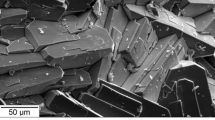Abstract
Maps of the electrostatic potentials at the basal plane of talc and pyrophyllite, computed using a two-dimensional Ewald lattice-sum, reveal the effects caused by structural distortion of the phyllosilicate layer. Rotation and tilting of basal tetrahedra in phyllosilicates dramatically perturb the electrostatic potential near the (001) surface. A potential high exists at the center of each six-fold ring of the talc (001) surface. Concerted counter-rotations of basal tetrahedra by 10°, as are typical in pyrophyllite, cause the potential lows above basal oxygens rotated into the ring to overlap, eliminating the ring-centered potential highs. Expansion of the vacant site in dioctahedral minerals tilts the basal tetrahedra by 4° and moves one-third of the basal oxygens about 0.2 Å toward the center of each phyllosilicate layer and away from the (001) surface, thereby producing corrugations of the basal surface. This shift dramatically reduces the contribution of these displaced basal oxygens to the (001) surface potential. Rotation and tilting of basal tetrahedra may influence the arrangement of interlayer water molecules on smectites and other swelling phyllosilicates by the effect that these distortions have on the (001) surface potential.
Similar content being viewed by others
References
Alcover, J. F. and Giese, R. F. (1986) Energie de laison des feuillets de talc, pyrophyllite, muscovite et phlogopite: Clay Miner. 21, 159–169.
Appelo, C. A. (1978) Layer deformation and crystal energy of micas and related minerals. I. Structural models for M and 2Af, polytypes: Amer. Mineral. 63, 782–792.
Appelo, C. A. (1979) Layer deformation and crystal energy of micas and related minerals. II. Deformation of the coordination units: Amer. Mineral. 64, 424–431.
Bailey, S. W. (1966) The status of clay mineral structures: in Clays and Clay Minerals, Proc. 14th Natl. Conf, Berkeley, California, 1965, S. W. Bailey, ed., Pergamon Press, New York, 1–23.
Bailey, S. W. (1980) Structures of layer silicates: in Crystal Structures of Clay Minerals and their X-ray Identification, G. W. Brindley and G. Brown, eds., Mineralogical Society, London, 2–123.
Bleam, W. F. and Hoffmann, R. (1988) Orbital interactions in phyllosilicates: Perturbations of an idealized two-dimensional, infinite silicate frame: Phys. Chem. Minerals 15, 398–408.
Brown, I. D. (1978) Bond valences—A simple structural model for inorganic chemistry: Chem. Soc. Rev. 7, 359–376.
Brown, I. D. and Shannon, R. D. (1973) Empirical bond-strength-bond-length curves for oxides: Acta Crystallogr. A29, 266–282.
Foot, J. D. and Colburn, E. A. (1988) Electrostatic potentials for surfaces of inorganic and molecular crystals: J. Mol. Graphics 6, 93–99.
Giese, R. F. (1975) Interlayer bonding in talc and pyrophyllite: Clays & Clay Minerals 23, 165–166.
Grim, R. E. (1968) Clay Mineralogy: McGraw-Hill Book Co., New York, 506 pp.
Heyes, D. M. and van Swol, F. (1981) The electrostatic potential and field in the surface region of lamina and semi-infinite point charge lattices: J. Chem. Phys. 75, 5051–5058.
Jenkins, H. D. B. and Hartman, P. (1979) A new approach to the calculation of electrostatic energy relations in minerals: The dioctahedral and trioctahedral phyllosilicates: Philos. Trans. Royal Soc. London Ser. A 293, 169–208.
Lee, W. W. and Choi, S.-I. (1980) Determination of the Madelung potential of ionic crystals with a polar surface by the Ewald method: J. Chem. Phys. 72, 6164–6168.
Newham, R. E. (1961) A refinement of the dickite structure and some remarks on polymorphism in kaolinite minerals: Mineral. Mag. 32, 683–704.
Parry, D. E. (1975) The electrostatic potential in the surface region of an ionic crystal: Surface Sci. 49, 433–440.
Parry, D. E. (1976) Errata: The electrostatic potential in the surface region of an ionic crystal: Surface Sci. 54, 195.
Pauling, L. (1930) The structure of the micas and related minerals: Proc. Natl. Acad. Sci. U.S.A. 16, 123–129.
Pentinghaus, H. (1975) Hexacelsian: Fortschr. Mineral. Suppl. 753, 65.
Radoslovich, E. W. (1963) The cell dimensions and symmetry of layer-lattice silicates. IV. Interatomic forces: A mer. Mineral. 48, 76–99.
Smith, E. R. (1983) Electrostatic potential at a plane surface of a point ionic crystal: Physica 120A, 327–338.
Smith, J. V. (1977) Enumeration of 4-connected 3-dimen-sional nets and classification of framework silicates. I. Perpendicular linkage from simple hexagonal net: Amer. Mineral. 62, 703–709.
Takéuchi, Y. (1958) A detailed investigation of the structure of hexagonal BaAl2Si2O8 with reference to its a-ß inversion: Mineral. J. 2, 311–332.
Takéuchi, Y. and Donnay, G. (1959) The crystal structure of hexagonal CaAl2Si,O8: Acta Crystallogr. 12, 465–470.
Zvyagin, B. B., Mishchenko, K. S., and Soboleva, S. V. (1969) Structure of pyrophyllite and talc in relation to polytypes of mica-type minerals: Soviet Phys. Crystallogr. (Engl, trans.) 13, 511–515.
Zvyagin, B. B., Soboleva, S. V., Vrublevskaya, Z. V., Zhu-khlistov, A. P., and Fedotov, A. F. (1972) Factors in the di trigonal rotation of the tetrahedra in the structures of layer silicates: Soviet Phys. Crystallogr. (Engl, trans.) 17, 466–469.
Author information
Authors and Affiliations
Rights and permissions
About this article
Cite this article
Bleam, W.F. Electrostatic Potential at the Basal (001) Surface of Talc and Pyrophyllite as Related to Tetrahedral Sheet Distortions. Clays Clay Miner. 38, 522–526 (1990). https://doi.org/10.1346/CCMN.1990.0380509
Received:
Accepted:
Published:
Issue Date:
DOI: https://doi.org/10.1346/CCMN.1990.0380509




